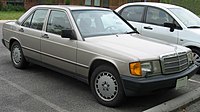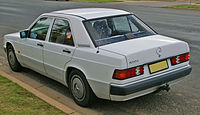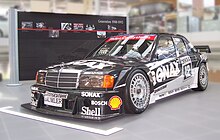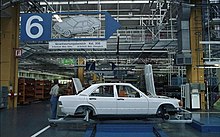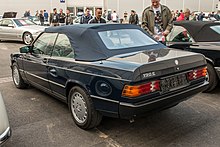Mercedes-Benz W 201
| Mercedes Benz | |
|---|---|
|
Mercedes-Benz 190 E (1982–1988)
|
|
| W 201 | |
| Sales designation: | 190 |
| Production period: | 1982-1993 |
| Class : | Middle class |
| Body versions : | limousine |
| Engines: |
Otto engines : 1.8–3.2 liters (66–172 kW) Diesel engines : 2.0–2.5 liters (53–93 kW) |
| Length: | 4420-4448 mm |
| Width: | 1678-1706 mm |
| Height: | 1361-1390 mm |
| Wheelbase : | 2665 mm |
| Empty weight : | 1080-1340 kg |
| successor | Mercedes-Benz 202 series |
The Mercedes-Benz W201 is the first Mercedes of the middle class and forerunner of the C-Class . It was aimed primarily at the buyers of the successful BMW 3 Series .
The W 201 was always marketed as the Mercedes-Benz 190 , regardless of the engine's displacement. Mercedes-Benz presented it on December 8, 1982 and produced more than 1.8 million units by August 1993. This makes it one of the most successful models from Mercedes-Benz.
Model history
General
The Mercedes-Benz W 201 marks the transition to a new generation of vehicles for Daimler-Benz. Multi-link rear axle, newly developed encapsulated diesel engines and a streamlined and functional body represent the new style. The W 201 was produced for over 10 years and was primarily intended to oppose the BMW 3 Series , which achieved high sales figures in the USA.
At the same time, the 1974 oil crisis demonstrated the need for a more economical and compact model. Nonetheless, the passive safety was at a high level: With an offset crash design, anti-lock braking system and driver airbag, the W 201 offered equipment features that the competition only offered in this segment around 10 years later.
The mid-range Mercedes-Benz W 124 series in particular was to be strongly influenced by the concept. This applies to both the design characteristics and essential technical features. Paradoxically, at the time of its introduction, the prices of the W 201 were above those of the W 123 mid-range sedan, although it was positioned in a higher segment.
The start of sales of the new model was disappointing at first. Due to the successive expansion of the model range (the 190 Diesel and the sports model 190 E 2.3-16 followed in 1983), the new model quickly enjoyed great popularity, so that delivery times of a few months became common.
technology
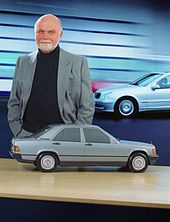
The W 201 is the first Mercedes car with the so-called multi-link rear axle . She has five per wheel steering , which at the knuckle and the rear subframe of the body at a respective rubber bearings are held. Each of these links takes one of the six degrees of freedom of the movement of a body in space from the steering knuckle, so that just one degree of freedom remains for the compression and rebound. One of the lower links carries the spring. Compared to conventional axles, this construction offers more options to adjust the change in camber and toe-in depending on the deflection and the acting forces (elastokinematics) and still comfortably suspend the bike in the longitudinal and transverse directions. It is more compact than the semi-trailing arm axle previously used and a quarter lighter. The "stem axis" was developed by Manfred von der Ohe.
The front axle is a comparatively simple strut axle with a triangular wishbone on which the coil spring acts. Both axes have a torsion bar stabilizer .
A “normal” handbrake lever on the center console takes over the function of the typical Mercedes foot parking brake . The reason for this is the relatively narrow footwell of the car, which did not offer space for a parking pedal. Another new feature is the single-arm wiper, which was equipped with special lifting technology from autumn 1984 and thus covered a larger area - according to Mercedes-Benz AG, up to 86% of the window pane. It was also used in the 124 series introduced in November 1984 , in the successor series 202 and other later models.
Initially, the models were offered as the 190 and 190 E (with the M102 petrol engine ); From autumn 1983 the 53 kW diesel variant 190 D ( OM601 ) and the sport version 190 E 2.3-16 ( M102 with four valves per cylinder and 136 kW / 185 hp) added to the range. From 1985 further models were offered, the 190 D 2.5 ( OM602 ) with 66 kW, the 190 E 2.3 with 100 kW and the 190 E 2.6 with a 122 kW six-cylinder in- line engine ( M 103 ). The 190 D 2.5 was later delivered in a turbo version increased to 90 kW, initially with a four-speed automatic transmission as standard. The 180 E was reserved for export markets . The new generation of sixteen-valve valves was presented at the 1986 Paris Motor Show. The 190 E 2.5-16 model with 143 kW (195 hp) is also making a name for itself as an Evo racing touring car.
The 16-valve engines are the result of a cooperation with the engine developer Cosworth and were also offered in some markets as the 190 E 2.3-16 Cosworth . The tuning model 190 E 3.2 AMG with 172 kW (234 hp) was also sold through Mercedes-Benz dealers from 1992.
design
Basically, the proportions of the W 201 were retained up to the 203 model series . The design with the relatively short, high and tapering rear broke radically with the previous Mercedes models. The W 201 was also the first Mercedes - with the exception of the radiator grille - to do without chrome jewelry. The drag coefficient (C w ) is, according to Daimler-Benz in 1983 at 0.33. Mercedes later included design elements of the W 201 in the mid-range and upper-class models of the 124 and 140 series .
Facelift
In September / October 1988 the following changes were made as part of a major facelift :
- new painted bumpers and side planks (" Sacco boards ")
- new seats with tilt adjustment, new upholstery and foam core instead of spring core
- Height adjustable belts at the front
- electrically heated exterior mirror, electrically adjustable on the right
- hematite-colored anodized window frames
In the spring of 1991 the exhaust system of the 190 E 2.0 and 2.3 was changed, whereby both variants got back the 3 kW lost by the catalytic converter. They now produced 90 and 100 kW again.
Special models
In 1992 there was the Avantgarde special model series . The range consisted of three models (named: Azzurro, Rosso and Verde), which were sold in limited numbers. On the one hand, the models each had a special tone-on-tone metallic paint finish and, on the other hand, a striking interior. The Avantgarde lettering is on the right-hand side of the glove compartment lid on all models.
- 190 E 2.3 Azzurro (blue), approx. 950 pieces
- 190 E 1.8 Rosso (red), approx. 2300 pieces
- 190 D 2.5 Verde (green), approx. 750 pieces
Other special models:
- 190 E 2.5-16 Evolution, 1989, 502 pieces, blue black metallic
- 190 E 2.5-16 Evolution II, 1990, 502 pieces, blue-black metallic
- Berlin 2000 , 190 E 1.8 / 2.3 / 3.2 AMG, 1992, 190 pieces
- DTM '92 , 190 E 1.8 / 2.3, 1992, brilliant silver or blue black metallic
- 190 E 3.2 AMG , from 1992
- 190 E 1.8 / 2.3 Primavera, 1993, green metallic of the Avantgarde series (only built for Switzerland)
- 190 Limited Edition 1.8 / 2.0, from 1992, 1000 pieces, velvet blue, brilliant silver, burgundy red (only built for the English and Irish markets)
- 190 Limited Edition 2,3, 1993, 1400 pieces, emerald green, black (only built for the American market)
Engines
For a number of years Mercedes-Benz offered both models with catalytic converters (KAT) and without (RÜF). The RÜF models could be retrofitted at a later date. The versions without a catalytic converter had a slightly higher performance. The performance deficit of the 190 E 2.0 and 2.3 models caused by the introduction of the catalytic converter was compensated for from 1991 by using the exhaust system of the 190 E 2.6. The output increased from 87 to 90 kW for the 2.0 and from 97 to 100 kW for the 2.3.
Otto engines:
| model | construction time | Engine type | compression | cylinder | Valves per cylinder |
drilling
x Stroke [mm] |
Cubic capacity [cm 3 ] |
Power [kW / PS] at speed [1 / min] |
Torque [Nm] at speed [1 / min] |
Remarks |
|---|---|---|---|---|---|---|---|---|---|---|
| 190 | 1982-1984 | M 102 | 9.1: 1 | 4th | 2 | 1997 | 66/90 at 5000 | 165 at 2500 | not for E10 fuel suitable | |
| 1984-1988 | 77/105 at 5200 | 170 at 2500 | ||||||||
| 190 (RÜF) | 1985-1988 | 77/105 at 5500 | 165 at 3000 | |||||||
| 190 (KAT) | 1985-1990 | 75/102 at 5500 | 160 at 3000 | |||||||
| 190 E | 1982-1988 | 90/122 at 5100 | 178 at 3500 | |||||||
| 190 E (RÜF) | 1985-1988 | |||||||||
| 190 E (KAT) | 1985-1991 | 87/118 at 5100 | 172 at 3500 | |||||||
| 190 E 1.8 | 1990-1993 | 9: 1 | 1797 | 80/109 at 5500 | 150 at 3700 | |||||
| 190 E 2.0 | 1991-1993 | 1996 | 90/122 at 5300 | 175 at 3500 | ||||||
| 190 E 2.3 | 1985-1988 | 2299 | 100/136 at 5100 | 205 at 3500 | not suitable for E10 fuel | |||||
| 190 E 2.3 (RÜF) | ||||||||||
| 190 E 2.3 (KAT) | 1985-1991 | 97/132 at 5100 | 198 at 3500 | |||||||
| 190 E 2.3 | 1991-1993 | 9: 1 | 2298 | 100/136 at 5200 | 200 at 3500 | |||||
| 190 E 2.3-16 (ECE) | 1984-1988 | 10.5: 1 | 4th | 95.5 x 80.25 | 2299 | 136/185 at 6200 | 235 at 4500 | not suitable for E10 fuel | ||
| 190 E 2.3-16 (RÜF) | 1983-1984 | 9.7: 1 | 95.5 x 80.25 | 130/177 at 5800 | 230 at 4750 | |||||
| 190 E 2.3-16 (KAT) | 1982-1987 | 9.2: 1 | 95.5 x 80.25 | 125/170 at 5800 | 220 at 4750 | |||||
| 190 E 2.5-16 (RÜF) | 1987-1988 | 9.7: 1 | 95.5 x 87.2 | 2498 | 150/204 at 6750 | 240 at 5000-5500 | not suitable for E10 fuel | |||
| 190 E 2.5-16 (KAT) | 07 / 1988-06 / 1993 | 9.7: 1 | 95.5 x 87.2 | 143/195 at 6800 | 235 at 5000-5500 | |||||
| 190 E 2.5-16 Evolution (RÜF) | 03 / 1989-05 / 1989 | 9.7: 1 | 97.3 x 82.8 | 2463 | 150/204 at 6750 | 240 at 5000-5500 | not suitable for E10 fuel | |||
| 190 E 2.5-16 Evolution (KAT) | 9.7: 1 | 97.3 x 82.8 | 143/195 at 6800 | 235 at 5000-5500 | ||||||
| 190 E 2.5-16 Evolution II (KAT) | 05 / 1990-07 / 1990 | 10.5: 1 | 97.3 x 82.8 | 173/235 at 7200 | 245 at 5000-6000 | |||||
| 190 E 2.6 | 1985-1988 | M 103 | 6th | 2 | 2597 | 122/166 at 5800 | 228 at 4600 | not suitable for E10 fuel | ||
| 190 E 2.6 (RÜF) | ||||||||||
| 190 E 2.6 (KAT) | 1985-1992 | 118/160 at 5800 | 220 at 4600 | |||||||
| 190 E 3.2 AMG | 1992 | 3206 | 172/234 at 5750 | 305 at 4500 |
Diesel engines:
| model | Model | construction time | Engine type | Cubic capacity [cm 3 ] |
Power [kW / PS] at speed [1 / min] |
Torque [Nm] at speed [1 / min] |
|---|---|---|---|---|---|---|
| 190 D | 201.122 | 08 / 1983-05 / 1989 | OM 601 .911 | 1997 | 53/72 at 4600 | 123 at 2800 |
| 190 D | 06 / 1989-08 / 1993 | 55/75 at 4600 | 126 at 2700-3550 | |||
| 190 D 2.2 | 201.122 | 1983-1985 | OM 601.921 | 2197 | 54/73 at 4200 | 130 at 2800 |
| 190 D 2.5 | 201.126 | 09 / 1985-05 / 1989 | OM 602 .911 | 2497 | 66/90 at 4600 | 154 at 2800 |
| 190 D 2.5 | 06 / 1989-08 / 1993 | 69/94 at 4600 | 158 at 2600-3100 | |||
| 190 D 2.5 turbo | 201.128 | 09 / 1988-05 / 1989 | OM 602.961 | 90/122 at 4600 | 225 at 2400 | |
| 190 D 2.5 turbo | 06 / 1989-08 / 1993 | 93/126 at 4600 | 231 at 2400 |
Mercedes 190 DTM versions
The Mercedes-Benz 190 E 2.5-16 achieved great success in the 1992 racing season: it won 16 of 24 races in the German Touring Car Championship (DTM) and finished first to third in the final accounts. To date, no other car has collected more victories, more points, more best practice times, more fastest laps and more lead kilometers in a DTM season than the 190 E 2.5-16 prepared by Mercedes-Benz in-house tuner AMG in its second evolutionary stage (abbreviation EVO II ).
Thanks to four-valve technology and Motronic, the 2.5-liter four-cylinder in the winning car driven by works driver Klaus Ludwig produces around 272 kW (370 hp) at 9,500 rpm. Consistent weight savings mean that the EVO II weighs just 980 kilograms when ready to drive. It accelerates from standstill to 100 km / h in 4.5 seconds. It delivers its power via a straight-toothed six-speed gearbox to the rear axle with a mechanical differential lock. Shifting takes place without using the clutch at full throttle . The cylinder head of the engine came from the British company Cosworth .
production
The total number of all Mercedes-Benz W 201s produced amounts to around 1.9 million units. A special feature was that for the first time in the history of Daimler-Benz a model was produced at two locations at the same time. The Bremen plant built exactly 58% of the vehicles . The other 42% of the vehicles were manufactured in the Sindelfingen plant.
About 53% of the vehicles built were sold in Germany, only every tenth vehicle in the USA. This ratio was unusually low at Daimler-Benz, especially since the impetus for development came primarily from the USA. The most popular types were the 190 E 2.0 (around 34%) and the 190 D (24%). Although it was only introduced in 1990, the 190 E 1.8 was able to achieve a third of the market in a short time, possibly due to its good price-performance ratio Take total sales for yourself.
The last Mercedes-Benz W 201 was built in the Bremen plant in August 1993 and handed over to the Mercedes-Benz Museum . The successor to the W 201 was the 202 series under the designation “C-Class” in 1993 .
| Total number of units Mercedes-Benz W 201 | |
|---|---|
| All in all | 1,879,629 pieces |
| Share of diesel versions | 33.6% |
| Share of six-cylinder versions | 5.6% |
| Share of sixteen valve versions | 1.4% |
| Share of special models | 0.4% |
Existence in Germany
Listed is the inventory of Mercedes-Benz W 201 with initial registration from 1990 and evaluable vehicle identification number in Germany on January 1st every year since 2003 according to statistics from the Federal Motor Transport Authority . Until 2007, the inventory included the number of vehicles registered as well as the number of temporary shutdowns. Since 2008, the inventory has only included "flowing traffic" including the seasonal license plates. The inventory as of January 1, 2007 was retrospectively converted to the new recording method.
| Deadline | 1.1.2003 | 1.1.2004 | 1.1.2005 | 1.1.2006 | 1.1.2007 |
|---|---|---|---|---|---|
| number | 202.183 | 192,448 | 179,371 | 164,639 | 149.815 |
| change | - 4.8% | - 6.8% | - 8.2% | - 9.0% | |
| source |
| Deadline | 1.1.2007 | 1.1.2008 | 1.1.2009 | 1.1.2010 | 1.1.2011 | 1.1.2012 | 1.1.2013 | 1.1.2014 | 1.1.2015 |
|---|---|---|---|---|---|---|---|---|---|
| number | 128,582 | 114,098 | 102.007 | 86,954 | 78,819 | 71.005 | 63,299 | 56,281 | 50,574 |
| change | - 11.3% | - 10.6% | - 14.8% | - 9.4% | - 9.9% | - 10.9% | - 11.1% | - 10.1% | |
| source |
The total number of Mercedes-Benz W 201 vehicles on January 1, 2002 in Germany was around 518,500 vehicles. With almost 100,000 registrations on January 1, 2013, according to the VDA , the Mercedes-Benz W 201 is the fourth most popular classic car in Germany after the Mercedes-Benz W 124 , the Audi 80 B3 / B4 and the VW Golf II .
According to the final report of the Federal Office of Economics and Export Control , 13,836 Mercedes-Benz W 201s were scrapped in favor of the environmental bonus between January 27, 2009 and July 31, 2010.
On December 7, 2012, the first Mercedes-Benz W 201 received an H license plate .
Trivia
The vehicles of the W 201 series were commonly referred to as "Baby Benz".
To mislead the public, the Erlkönig of the W 201 was christened Ushido by Mercedes-Benz .
Kaengsaeng 88
In 1988, the Sungri engine factory in North Korea copied the models of the Mercedes-Benz W 201 illegally and without the approval of Daimler-Benz AG and produced small numbers. Individual imported original vehicles from Mercedes-Benz were completely dismantled and all components were rebuilt. The vehicles designated as Kaengsaeng 88 had severe manufacturing defects. The model was alternatively named Pyongyang 4.10 .
literature
- Simsa, Paul (Ed.): The Mercedes-Benz 190. Portrait of an automobile , Econ-Verlag Düsseldorf 1986.
- Schwartz, Egbert / Gerstl, Theo: Mercedes 190. Everything about the legendary Baby-Benz W 201 , Geramond-Verlag Munich 2012.
- Neßhöver, Jost (Ed.): Mercedes-Benz 190 (W 201). Development - Models - Technology , Heel-Verlag Königswinter 2012.
- Schneider, Hans J./Schneider, Valentin / Schrader, Halwart: Mercedes 190. Model history - purchase advice - breakdown assistance, Schneider-Media-Verlag 2014.
- Purchase advice in Oldtimer Markt , issue 10/2007, p. 36 ff.
Web links
- Extensive further information
- Extensive collection of information
- Motors, technical data, color and upholstery tables
- Adam and Evo II - The Mercedes-Benz 190 E 2.5 Evolution II
- New price calculator, determine the original W201 price at that time using the data in the original price lists online
Individual evidence
- ↑ The star will still shine in 100 years , In: Der Spiegel , No. 37, September 9, 1985, p. 44.
- ↑ https://www.auto-motor-und-sport.de/reise/technik-der-raumlenkerachse-revolution-an-der-hinterachse/
- ↑ a b c d e f List of Mercedes-Benz car models that are not suitable for the E10
- ↑ Number of passenger cars on January 1, 2003 by segment and type group (registrations from 1990). (PDF; 109 kB) Federal Motor Transport Authority, accessed on October 22, 2015 .
- ↑ Number of passenger cars on January 1, 2004 by segment and model series (registrations from 1990). (PDF; 121 kB) Federal Motor Transport Authority, accessed on October 22, 2015 .
- ↑ Number of passenger cars on January 1, 2005 by segment and model series (registrations from 1990). (PDF; 131 kB) Federal Motor Transport Authority, accessed on October 22, 2015 .
- ↑ Number of passenger cars on January 1, 2006 by segment and model series (registrations from 1990). (PDF; 143 kB) Federal Motor Transport Authority, accessed on October 22, 2015 .
- ↑ Number of passenger cars on January 1, 2007 compared to January 1, 2006 by segment and model series (registrations from 1990). (PDF; 140 kB) (No longer available online.) Federal Motor Transport Authority, archived from the original on July 16, 2014 ; accessed on October 22, 2015 . Info: The archive link was inserted automatically and has not yet been checked. Please check the original and archive link according to the instructions and then remove this notice.
- ↑ a b Number of passenger cars on January 1, 2008 compared to January 1, 2007 by segment and model series (registrations from 1990). (PDF; 181 kB) (No longer available online.) Federal Motor Transport Authority, archived from the original on July 18, 2014 ; accessed on October 22, 2015 . Info: The archive link was inserted automatically and has not yet been checked. Please check the original and archive link according to the instructions and then remove this notice.
- ↑ Number of passenger cars on January 1, 2009 compared to January 1, 2008 by segment and model series (registrations from 1990). (PDF; 177 kB) (No longer available online.) Federal Motor Transport Authority, archived from the original on July 19, 2014 ; accessed on October 22, 2015 . Info: The archive link was inserted automatically and has not yet been checked. Please check the original and archive link according to the instructions and then remove this notice.
- ↑ Number of passenger cars on January 1, 2010 compared to January 1, 2009 by segment and model series (registrations from 1990). (PDF; 352 kB) (No longer available online.) Federal Motor Transport Authority, archived from the original on March 5, 2016 ; accessed on October 22, 2015 . Info: The archive link was inserted automatically and has not yet been checked. Please check the original and archive link according to the instructions and then remove this notice.
- ↑ Number of passenger cars on January 1, 2011 compared to January 1, 2010 by segment and model series (registrations from 1990). (PDF; 298 kB) (No longer available online.) Federal Motor Transport Authority, archived from the original on April 2, 2015 ; accessed on October 22, 2015 . Info: The archive link was inserted automatically and has not yet been checked. Please check the original and archive link according to the instructions and then remove this notice.
- ↑ Number of passenger cars on January 1, 2012 compared to January 1, 2011 by segment and model series (registrations from 1990). (PDF; 603 kB) Federal Motor Transport Authority, accessed on October 22, 2015 .
- ↑ Number of passenger cars on January 1, 2013 compared to January 1, 2012 by segment and model series (registrations from 1990). (PDF; 182 kB) Federal Motor Transport Authority, accessed on October 22, 2015 .
- ↑ Number of passenger cars on January 1, 2014 compared to January 1, 2013 by segment and model series (registrations from 1990). (PDF) Federal Motor Transport Authority, accessed on October 22, 2015 .
- ↑ Number of passenger cars on January 1, 2015 compared to January 1, 2014 by segment and model series (registrations from 1990). (PDF) Federal Motor Transport Authority, accessed on October 22, 2015 .
- ↑ Living legends. (PDF) In: Press report 2003. Kraftfahrt-Bundesamt, p. 17 , accessed on October 22, 2015 .
- ↑ 30 years of the VW Golf II. Really ready for the H license plate? (PDF) In: Auto Bild Klassik 1/2014. January 2014, p. 51 , archived from the original on April 17, 2015 ; accessed on October 22, 2015 .
- ↑ Final report - environmental bonus. (PDF; 1.6 MB) Federal Office for Economics and Export Control and Federal Motor Transport Authority, November 1, 2010, accessed on October 22, 2015 .
- ↑ Ralf Weber, Thomas Frankenstein: The first Mercedes-Benz 190 (W201) with H license plate. Classic status for the Baby Benz! Mercedes fans, January 22, 2013, accessed October 22, 2015 .
- ↑ : https://www.welt.de/motor/modelle/article125619819/Zuverlaessiger-als-der-alte-Baby-Benz- geht-nicht.html
- ↑ The impetus for the W 201 comes from the USA - Daimler invents the USHIDO brand, January 20, 2014 mercedes-fans.de (accessed on November 23, 2019)
- ^ Illustration of a Kaengsaeng 88 on the website www.caranddriver.com (accessed on December 2, 2015).
- ↑ PYONGYANG 4.10, also named KAENGSAENG 88 | chinesecars. In: www.chinesecars.net. Retrieved October 20, 2015 .
| Vehicle class | 1920s | 1930s | 1940s | ||||||||||||||||
| 6th | 7th | 8th | 9 | 0 | 1 | 2 | 3 | 4th | 5 | 6th | 7th | 8th | 9 | 0 | 1 | 2 | 3 | 4th | |
| Compact class | W 15 (type 170) | ||||||||||||||||||
| W 23 (type 130) | |||||||||||||||||||
| W 30 (type 150) | |||||||||||||||||||
| W 28 (type 170 H) | |||||||||||||||||||
| Middle class | W 02 (type Stuttgart 200) | W 136 / W 149 (types 170 V / 200 V) | |||||||||||||||||
| W 11 (type Stuttgart 260) | W 143 (type 230 n) | ||||||||||||||||||
| W 21 (type 200/230) | W 153 (type 230) | ||||||||||||||||||
| W 138 (type 260 D) | |||||||||||||||||||
| upper middle class | W 03 / W 04 / W 05 (types 300/320/350) | W 18 (type 290) | |||||||||||||||||
| W 10 / W 19 (types 350/370/380) | W 142 (type 320) | ||||||||||||||||||
| W 22 | |||||||||||||||||||
| Upper class | Type 400 & Type 630 | W 24 / W 29 / W 129 (types 500 K / 540 K / 580 K) | |||||||||||||||||
| W 08 (type Nürburg 460/460 K / 500 / type 500 N) | |||||||||||||||||||
| W 07 / W 150 (types 770/770 K) | |||||||||||||||||||
| Sports car | Model K | ||||||||||||||||||
| W 06 (type S / SS / SSK / SSKL) | W 24 / W 29 / W 129 | ||||||||||||||||||
| Off-road vehicle | W 103 (type G1) | W 31 (type G4) | |||||||||||||||||
| W 133 III (type 170 VG) / W 139 (type 170 VL) / W 152 (type G5) | |||||||||||||||||||
| Vans | L 3/4 | L 1000 Express | L 301 | ||||||||||||||||
| L 300 | |||||||||||||||||||



